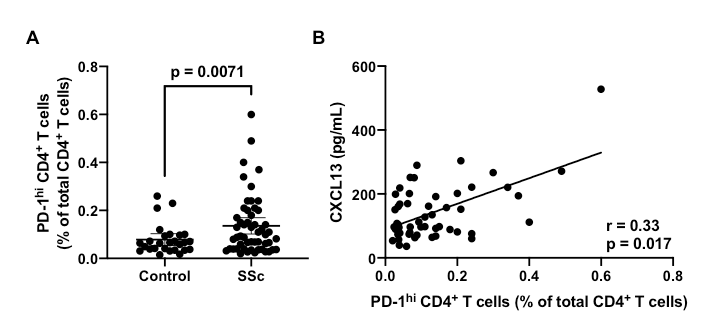Session Information
Date: Monday, November 11, 2019
Title: Systemic Sclerosis & Related Disorders – Basic Science Poster
Session Type: Poster Session (Monday)
Session Time: 9:00AM-11:00AM
Background/Purpose: Systemic sclerosis (SSc) is an autoimmune disease characterized by tissue fibrosis, vascular injury, and autoantibody production. CXCR5+ PD-1+ T follicular helper (Tfh) cells, which are T cells specialized to help B cells, are expanded in the circulation of SSc patients and may contribute to both immune activation and fibrotic organ damage. Emerging evidence supports the existence of a wider range of B cell-helper T cells characterized by high expression of PD-1 including PD-1hi CXCR5– T peripheral helper (Tph) cells, which are dramatically expanded in the joints of RA patients and in the circulation of SLE patients. Here, we have evaluated the frequency of PD-1hi CD4+ T cell subsets in a well-characterized cohort of SSc patients.
Methods: Peripheral blood mononuclear cells (PBMCs) were collected from 101 SSc patients fulfilling the 2013 ACR/EULAR SSc classification criteria and 33 healthy controls. A comprehensive set of demographic and clinical characteristics was obtained at the time of enrollment including data on organ involvement, disease severity, autoantibody profile, pulmonary and cardiac functional status, and medications. Flow cytometry analysis was performed on PBMCs using an antibody panel designed to identify specific CD4+ T cell subsets. Serum cytokine levels were measured by ELISA.
Results: Using strict gating on cells with very high PD-1 expression, we observed that the frequency of PD-1hi CD4+ T cells among total CD4+ T cells was significantly increased in SSc patients compared to healthy controls (0.136% vs. 0.078%, p = 0.0071; Figure 1A). The PD-1hi CD4+ population contains two distinct B cell-helper T cell subsets: CXCR5+ Tfh cells and CXCR5– Tph cells. Strict gating on CXCR5– cells indicated that PD-1hi CXCR5– Tph cells were also increased in SSc samples (p = 0.011). PD-1hi CD4+ T cell populations are the major source of the B cell chemoattractant CXCL13, and we observed a positive correlation between PD-1hi CD4+ T cell frequency and serum CXCL13 concentration in SSc patients (Spearman r = 0.33, p=0.017; Figure 1B). To evaluate clinical associations with PD-1hi CD4+ T cell frequency, we stratified SSc patients based on high (≥ 0.20%) or low (≤ 0.05%) PD-1hi CD4+ T cell frequency. We found that 58% (7/12) of patients with high PD-1hi CD4+ T cell numbers had interstitial lung disease (ILD) compared to 27% (4/15) of patients with low PD-1hi CD4+ T cell numbers.
Conclusion: Our study shows that the frequency of PD-1hi CD4+ T cells, including PD-1hi CXCR5– Tph cells, is significantly increased in SSc patients. Preliminary analyses suggest a relationship between PD-1hi CD4+ T cell frequency and SSc-ILD. These findings support a potential role for B cell-helper T cells including Tph cells in the autoimmune pathology of SSc.
To cite this abstract in AMA style:
Mueller A, Fava A, Rao D, Boin F. CD4+ T Helper Cell Populations with High PD-1 Expression Are Expanded in Systemic Sclerosis [abstract]. Arthritis Rheumatol. 2019; 71 (suppl 10). https://acrabstracts.org/abstract/cd4-t-helper-cell-populations-with-high-pd-1-expression-are-expanded-in-systemic-sclerosis/. Accessed .« Back to 2019 ACR/ARP Annual Meeting
ACR Meeting Abstracts - https://acrabstracts.org/abstract/cd4-t-helper-cell-populations-with-high-pd-1-expression-are-expanded-in-systemic-sclerosis/

